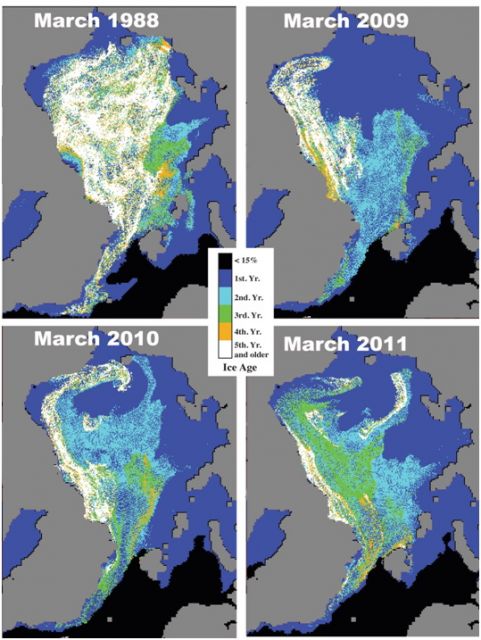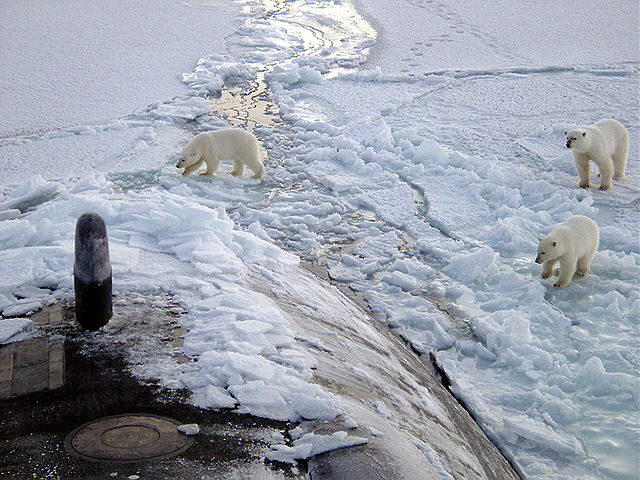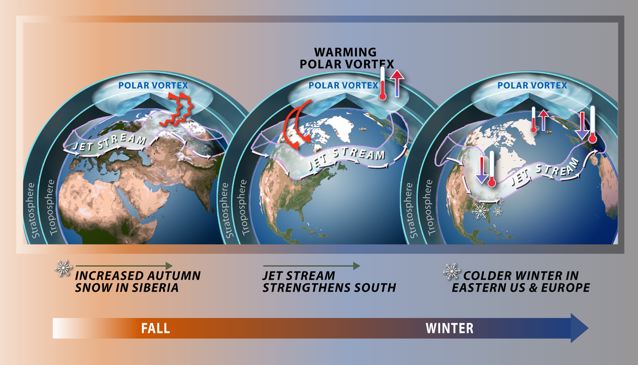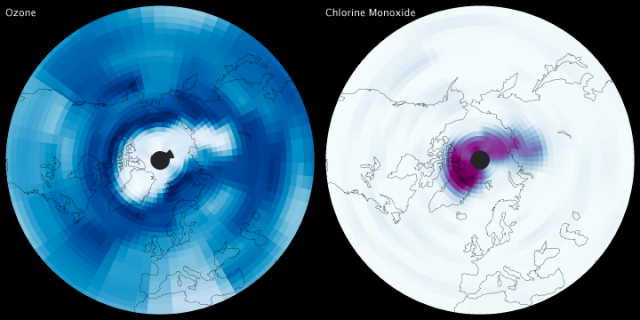 Icebergs breaking off glacier, Greenland. Credit: Mila Zinkova via Wikimedia Commons. NOAA released its 2011 Arctic report card. And then they confused the metaphors by using a traffic signal. *Sigh.*
Icebergs breaking off glacier, Greenland. Credit: Mila Zinkova via Wikimedia Commons. NOAA released its 2011 Arctic report card. And then they confused the metaphors by using a traffic signal. *Sigh.*
But if we follow through on the original metaphor, we get the following report card:
- Atmosphere: F
- Sea Ice & Ocean: F
- Hydrology & Terrestrial Cryosphere: F
- Marine Ecosystems : C
- Terrestrial Ecosystems: C
 Sea ice age in the first week of March derived from tracking the drift of ice floes in 1988, 2009, 2010 and 2011. Figure courtesy of J. Maslanik and C. Fowler, via NOAA.
Sea ice age in the first week of March derived from tracking the drift of ice floes in 1988, 2009, 2010 and 2011. Figure courtesy of J. Maslanik and C. Fowler, via NOAA.
The foremost conclusion of the report is that 2006 marked a major shift in the Arctic Ocean system.
The report doesn’t say ‘tipping point.’ But in fact it might well have been a tipping point. Here’s what this tippinglike point looks like:
- Persistent decline in the thickness of sea ice cover
- Persistent decline in the summer extent of sea ice cover
- A warmer upper ocean
- A fresher upper ocean
The tipping-ish part is that the system may not return to what it was before 2006. In other words, another new normal.
 Polar bears approach the submarine USS Honolulu (SSN 718) while surfaced 280 miles from the North Pole. : Credit: Chief Yeoman Alphonso Braggs, US Navy.The consequences of the tip are broad spectrum, impacting biology, chemistry, meteorology in (often) positive feedback loops.
Polar bears approach the submarine USS Honolulu (SSN 718) while surfaced 280 miles from the North Pole. : Credit: Chief Yeoman Alphonso Braggs, US Navy.The consequences of the tip are broad spectrum, impacting biology, chemistry, meteorology in (often) positive feedback loops.
For marine life, most consequences are a response to ever-smaller areas of ice and ever-larger areas of open water. Specifically:
- Biological productivity at the base of the marine food chain—aka phytoplankton—has increased
- Sea ice-dependent marine mammals—like polar bears and walrus—continue to lose habitat
Many of the changes underway for terrestrial life are linked to warmer temperatures in coastal regions, where sea ice used to keep things cool, but is now in retreat. Including:
- Increases in the greenness of tundra vegetation
- Increase in permafrost temperatures
 Increased autumn snow in Siberia predicts a weakening Arctic vortex in winter. : Credit: Nicolle Rager Fuller, National Science Foundation.A second key point from this report card is the repeat in 2011 of an anomalous wind pattern that first appeared in the Arctic winter of 2010. This weakening of the Arctic vortex led to the jet stream dipping south and warming Greenland and northeastern Canada, while bringing much colder temperatures to Europe and North America. The results:
Increased autumn snow in Siberia predicts a weakening Arctic vortex in winter. : Credit: Nicolle Rager Fuller, National Science Foundation.A second key point from this report card is the repeat in 2011 of an anomalous wind pattern that first appeared in the Arctic winter of 2010. This weakening of the Arctic vortex led to the jet stream dipping south and warming Greenland and northeastern Canada, while bringing much colder temperatures to Europe and North America. The results:
- Higher than normal temperatures in the Arctic
- Record ice sheet mass loss
- Record low late spring snow cover in Eurasia
- Shorter lake ice duration
- Unusually lower temperatures and snow storms in some low latitude regions

![]() Rare deep depletion in the ozone layer over the Arctic in 2011, much like the annual Antarctic ozone hole. : Credit: NASA Earth Observatory.
Rare deep depletion in the ozone layer over the Arctic in 2011, much like the annual Antarctic ozone hole. : Credit: NASA Earth Observatory.
On top of all that, the Arctic grew its own bona fide ozone hole last winter—one that threatens far more populated areas of the globe than the Antarctic hole, and one with the power to impact the winter crops that feed us. The executive summary of the report concludes:
The 2011 Report Card shows that record-setting changes are occurring throughout the Arctic environmental system. Given the projection of continued global warming, it is very likely that major Arctic changes will continue in years to come, with increasing climatic, biological and social impacts.









